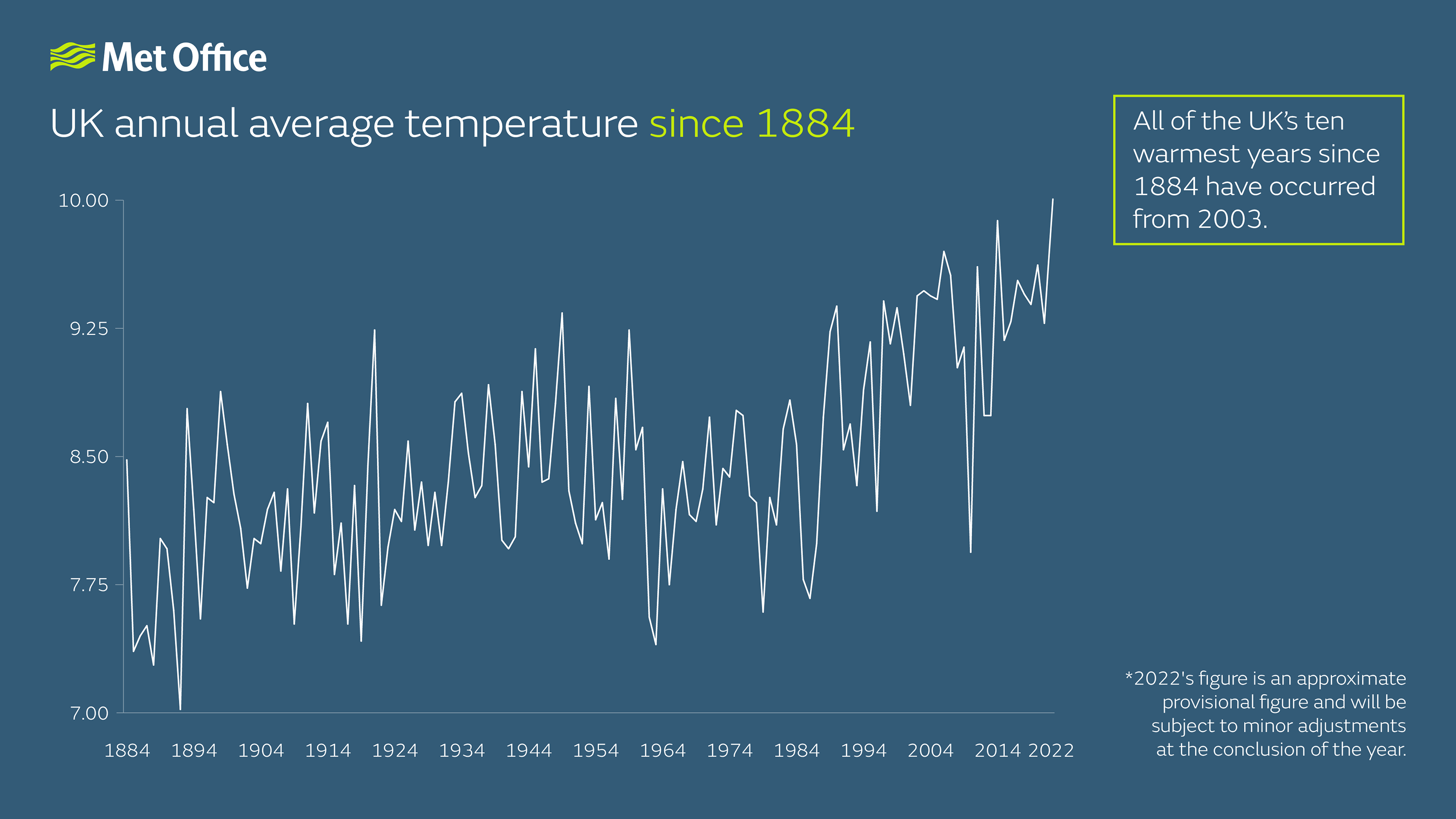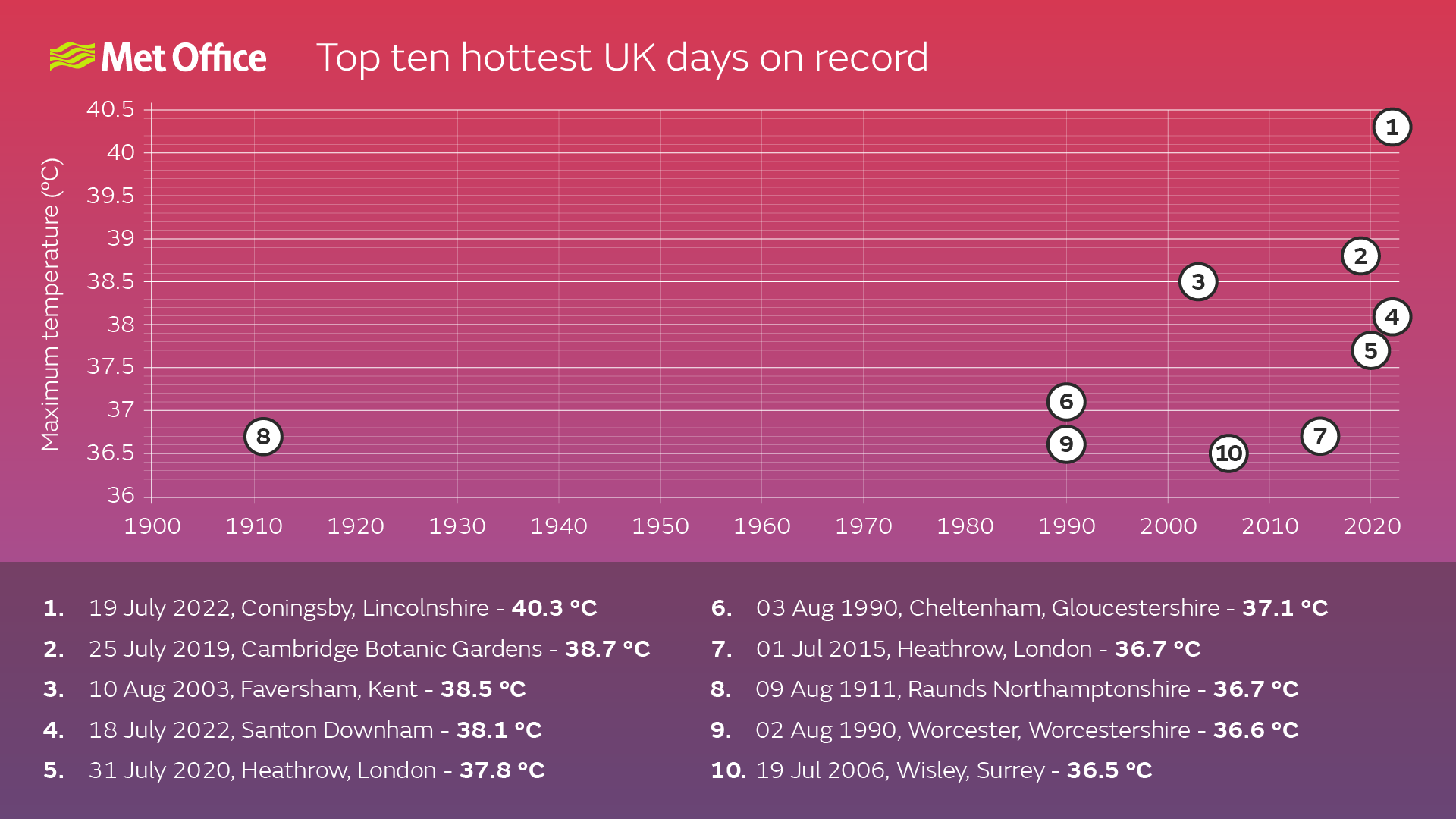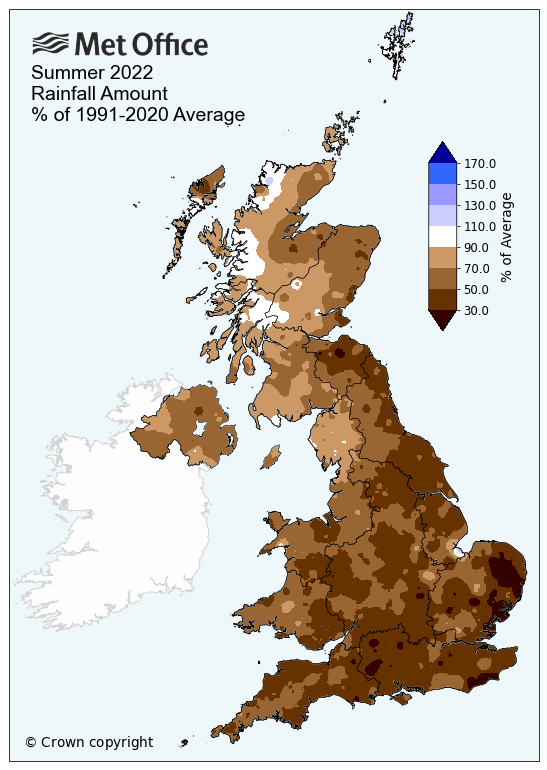2022 will be the warmest year on record for the UK, according to provisional Met Office figures.
All four seasons have fallen in the top ten in a series which began in 1884 and the 10 warmest years have all occurred since 2003.
As well as setting a new 139-year annual mean temperature record, 2022 will also be remembered for several other significant weather events.
2022 will see the highest annual average temperature across the UK, exceeding the previous record set in 2014 when the average was 9.88C. Since 1884, all the ten years recording the highest annual temperature have occurred from 2003. The final provisional figure for 2022 will be available at the conclusion of the year and will then be subject to further quality control and a verification process.
2022 will also be the warmest year on record in the 364-year Central England temperature series from 1659, the world’s longest instrumental record of temperature.

Dr Mark McCarthy is the head of the Met Office’s National Climate Information Centre. He said: “2022 is going to be the warmest year on record for the UK. While many will remember the summer’s extreme heat, what has been noteworthy this year has been the relatively consistent heat through the year, with every month except December being warmer than average.
“The warm year is in line with the genuine impacts we expect as a result of human-induced climate change. Although it doesn’t mean every year will be the warmest on record, climate change continues to increase the chances of increasingly warm years over the coming decades.”
The year started with a mild theme with New Year’s Day the warmest on record according to maximum temperature. 16.3C was recorded at St James’s Park, London and that mild theme was replicated through much of 2022 with more warmer than average days and fewer cooler than average days.
Temperatures remained above average for every month of the year in 2022, except December which has been cooler than average so far. While many will remember the unprecedented heat of July, it is the persistence of warmer than average conditions that have resulted in 2022 breaking the annual temperature record.
The fourth warmest summer in the series for the UK was underlined with temperatures in excess of 40C recorded in the UK for the first time. Coningsby, Lincolnshire, recorded the highest temperature, with 40.3C exceeding the previous UK record by 1.6C. The hot period in July saw the Met Office issue its first ever red warning for extreme heat with widespread impacts for the UK. Wales also recorded a new daily maximum temperature record of 37.1C, with Scotland seeing a new record of 34.8C.

Anomalously cold start to December
2022 has seen the coldest first two weeks of December since 2010. Temperatures dropped as low as –17.3C at Braemar on 13 December as cool northerly air influenced the UK weather. Up to 27 December, average mean temperature for the UK is just 2.4C, which is 1.8C below the average for the month.
In addition, while it wasn’t a White Christmas for the vast majority of the UK, some small amounts of snow and sleet were recorded falling on Christmas Day at some stations in the northwest of Scotland and parts of Northern Ireland, meaning it has technically been a White Christmas.
All four seasons in 2022 were in the top 10 warmest on record for the UK. Winter was the eighth warmest, spring the fifth warmest, summer the fourth warmest and autumn the third warmest.
Dr Mark McCarthy continued: “2022 has been dominated by higher than average temperatures. The record-breaking temperatures in July have certainly boosted the overall temperature values for the year, but that isn’t the full story.
“Temperatures have been above the 1991-2020 long term average for a large proportion of the year, and this is something that we can anticipate as we become increasingly affected by climate change. Met Office science has shown that the temperatures witnessed in mid-July would have been extremely unlikely in the pre-industrial period – the era before humanity started emitting lots of greenhouse gases from burning fossil fuels.
“However, as we have seen in the first two weeks of December, our climate is still subject to notable cold spells during the winter season, but our observational data show these have generally become less frequent and less severe as our climate warms.”
Aside from the record-breaking temperatures, one of the most notable discussion points for 2022 was the dry conditions. Aside from brief spells at the beginning of January and at the end of February, the UK’s total rainfall accumulation has remained persistently below average for the year.
Summer was the tenth driest on record for the UK, with the south and east of the country especially dry. Some locations in southern and eastern England recorded virtually no rain in July, and by the conclusion of August, the year had been at its driest at that point since 1976.

Dr Mark McCarthy added “Despite the recent rain, the year has still been dry for much of the country, especially so in the south and east.”
Norfolk, Suffolk and Essex are all on course to record a year in their respective top 10 driest on record. The exact positioning will be dictated by how wet the conclusion to December is.
The south of England has so far had only just over three quarters of the rainfall it would normally expect in a year.
At the other end of the scale, western areas of Scotland saw more rain on a more similar scale to long-term averages for the year, but even here many locations are likely to end the year drier than average.
The Western Isles, Perth and Kinross, Angus and Aberdeenshire are some regions that got closest to long-term average rainfall amounts for the year.
A total of four storms were named in 2022 but three of them came in the space of a week.
Storms Dudley, Eunice and Franklin impacted the UK in February 2022, with Storm Eunice resulting in red warnings for wind and saw a new highest maximum gust speed record for England set of 122mph at the Needles on the Isle of Wight.
Dr Mark McCarthy said: “There’s no evidence of a trend in storminess because of climate change, but this spell of impactful weather in February is certainly noteworthy. It was the first time three named storms had impacted the UK in a week, with Eunice being particularly impactful for much of southern England and Wales.”
“It’s also noteworthy that there haven’t been any named storms to impact the UK since that week in February.”
Sunshine
Sunshine hours have been in good supply in the UK for 2022 according to provisional Met Office figures.
With a few days of December still to go, the UK has already seen 9% more sunshine hours than average for the whole of the year. This has been spurred on by areas to the south and east. East Anglia has already had 20% more sunshine hours than its average, making it the sunniest year on record for the region, with some time left in the year for that figure to increase further.
“By the start of December the UK had already seen more sunshine hours than average for the whole of the year. The most consistently bright parts of the UK have been in the south and east. We already know that it’ll be a top 10 year for sunshine hours in the UK, with England likely to have sunshine figures in the top three sunniest years on record,” concluded Dr Mark McCarthy.







